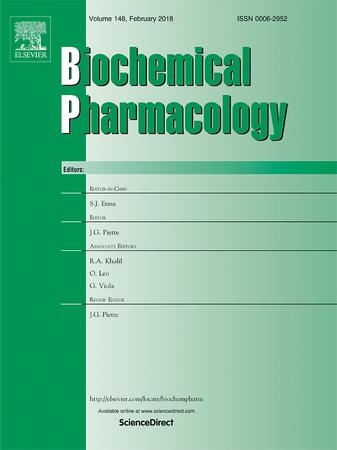司帕沙星通过抑制细胞衰老、JAK/NF-κB信号通路和调节肠道微生物代谢轴改善dss诱导的溃疡性结肠炎
IF 5.3
2区 医学
Q1 PHARMACOLOGY & PHARMACY
引用次数: 0
摘要
溃疡性结肠炎(UC)的进展涉及免疫失调、肠屏障功能障碍和微生物生态失调,而现有的靶向治疗存在挑战,包括不良反应和经济负担。UC的特征是持续的肠道炎症,表现为腹痛、便血和营养不良。长期不受控制的炎症可能导致结直肠癌或严重的并发症,显著降低生活质量。最近的研究表明,衰老细胞的病理积累与UC的发病机制有显著的相关性,提示抗衰老治疗是潜在的干预措施。在本研究中,我们通过高通量筛选发现氟喹诺酮类抗生素斯帕沙星(SPA)是一种有效的抗衰老药物,可显著缓解dss诱导的小鼠结肠炎。从机制上讲,结合细胞和动物实验以及转录组学、非靶向代谢组学和宏基因组学分析,我们证明了斯帕沙星的三方面治疗作用:①通过下调p16/p21的表达来抑制衰老;②有效抑制异常的JAK/NF-κB信号激活,同时降低促炎细胞因子(TNF-α, IL-6);③肠道菌群重塑以益生菌丰度增加和有益代谢物水平升高为特征。本研究首次阐明了SPA通过多靶点协同作用改善UC的分子机制,包括衰老抑制、抗炎作用和微生物群修复。本研究不仅拓展了氟喹诺酮类药物的临床应用,也为开发针对细胞衰老的UC综合治疗策略提供了理论基础。本文章由计算机程序翻译,如有差异,请以英文原文为准。

Sparfloxacin ameliorates DSS-induced ulcerative colitis by suppressing cellular senescence, JAK/NF-κB signaling pathway and modulation of the gut microbiota-metabolite axis
The progression of ulcerative colitis (UC) involves immune dysregulation, intestinal barrier dysfunction, and microbial dysbiosis while existing targeted therapies present challenges, including adverse effects and economic burdens. UC is characterized by persistent intestinal inflammation, manifesting as abdominal pain, hematochezia, and malnutrition. Prolonged uncontrolled inflammation may lead to colorectal cancer or severe complications, significantly impairing quality of life. Recent studies have revealed a significant correlation between pathological accumulation of senescent cells and UC pathogenesis, suggesting anti-senescence therapeutics as potential interventions. In this study, we identified sparfloxacin (SPA), a fluoroquinolone antibiotic, through high-throughput screening as an effective senolytic agent that markedly alleviates DSS-induced murine colitis. Mechanistically, combining cellular and animal experiments with transcriptomic, untargeted metabolomic, and metagenomic analyses, we demonstrated sparfloxacin’s tripartite therapeutic effects: ① Senescence inhibition via downregulation of p16/p21 expression; ② Effective suppression of aberrant JAK/NF-κB signaling activation with a concomitant reduction in pro-inflammatory cytokines (TNF-α, IL-6); ③ Gut microbiota remodeling characterized by increased probiotic abundance and elevated levels of beneficial metabolites. This study for the first time elucidates the molecular mechanism whereby SPA ameliorates UC through coordinated multi-target actions involving senescence inhibition, anti-inflammatory effects, and microbiome restoration. Our findings not only expand the clinical applications of fluoroquinolones but also provide a theoretical foundation for developing integrated UC treatment strategies targeting cellular senescence.
求助全文
通过发布文献求助,成功后即可免费获取论文全文。
去求助
来源期刊

Biochemical pharmacology
医学-药学
CiteScore
10.30
自引率
1.70%
发文量
420
审稿时长
17 days
期刊介绍:
Biochemical Pharmacology publishes original research findings, Commentaries and review articles related to the elucidation of cellular and tissue function(s) at the biochemical and molecular levels, the modification of cellular phenotype(s) by genetic, transcriptional/translational or drug/compound-induced modifications, as well as the pharmacodynamics and pharmacokinetics of xenobiotics and drugs, the latter including both small molecules and biologics.
The journal''s target audience includes scientists engaged in the identification and study of the mechanisms of action of xenobiotics, biologics and drugs and in the drug discovery and development process.
All areas of cellular biology and cellular, tissue/organ and whole animal pharmacology fall within the scope of the journal. Drug classes covered include anti-infectives, anti-inflammatory agents, chemotherapeutics, cardiovascular, endocrinological, immunological, metabolic, neurological and psychiatric drugs, as well as research on drug metabolism and kinetics. While medicinal chemistry is a topic of complimentary interest, manuscripts in this area must contain sufficient biological data to characterize pharmacologically the compounds reported. Submissions describing work focused predominately on chemical synthesis and molecular modeling will not be considered for review.
While particular emphasis is placed on reporting the results of molecular and biochemical studies, research involving the use of tissue and animal models of human pathophysiology and toxicology is of interest to the extent that it helps define drug mechanisms of action, safety and efficacy.
 求助内容:
求助内容: 应助结果提醒方式:
应助结果提醒方式:


